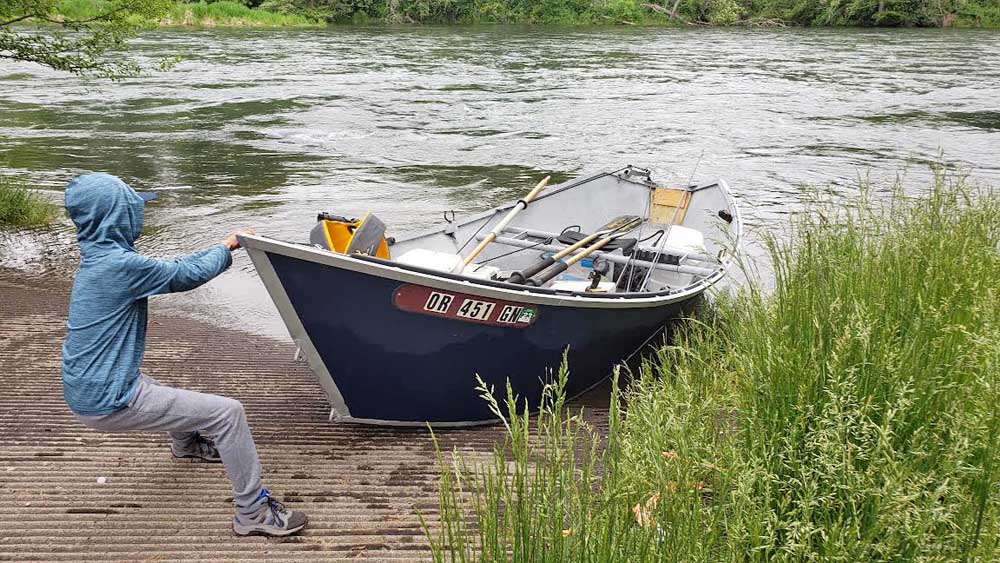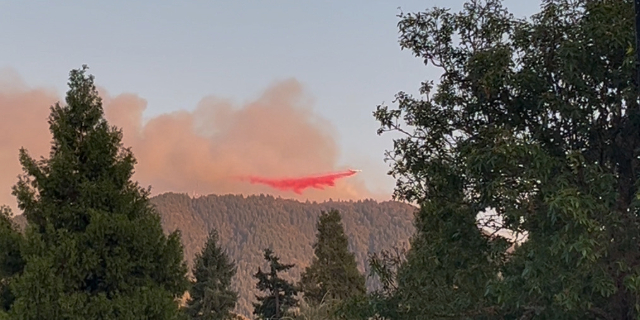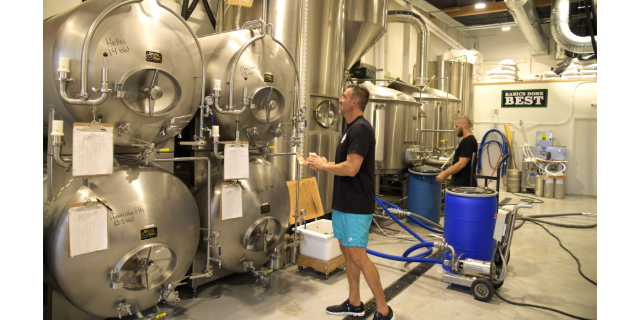Upper Rogue: The thrills and heartache of fishing for spring Chinook (copy)
Published 7:00 am Wednesday, May 24, 2023

- Liam Lusch helps at the Dodge Bridge boat ramp after spring Chinook fishing on Sunday.
It was cool and cloudy at dawn Sunday along the Rogue River downstream from Shady Cove, which is good weather and a great location for learning to fish for spring Chinook salmon.
Trending
“Right on time,” Rogue Valley Times photographer Jamie Lusch said at 6 a.m. sharp, as the newspaper’s newly hired outdoors writer and the author of this article arrived at the Dodge Bridge Park boat landing to learn from Lusch, a longtime fisherman, about catching the much-desired Chinook.
Or trying to catch.
“Rogue River spring Chinook are arguably one of the best-eating salmon in the world,” said Lusch, who still owns the 1974 Rogue River Special drift boat he earned during college summers working as a fishing guide on the Umpqua, Elk and Sixes rivers. Now, he fishes for the fun and excitement of it.
Trending
There was reason for excitement.
The river was flowing at a fast 4,100 cubic feet per second, which would make the fish less skittish, more prone to move and more likely to strike at the wiggling, irritating plugs that would be dangled in front of them.
They left the writer’s car at Dodge Bridge Park and rode in Lusch’s sport-utility vehicle, pulling a drift boat on a trailer, to a spot four miles upriver at Takelma County Park. A shuttle operator would later deliver the SUV and trailer back to Dodge Bridge so it would be waiting when we arrived back there.
Along for the trip was Lusch’s son, Liam, a fourth-grader and an experienced fisherman in his own right.
When we got to Takelma Park, six other rigs were already there.
“We got some competition,” Lusch said.
There’s only so many good fishing holes in a stretch of river.
This time of year, spring Chinook are headed upstream to spawn, swimming out of the strongest current during their journey to the hatchery area, Lusch said. The technique, Lusch explained, would be to hold the boat upstream of a hole and dangle the lures downstream to the hole.
Tied to the lures is a chunk of stinky sardine.
“Give it a scent,” Lusch said.
It’s what the salmon eat in the ocean, where they’ve spent the past few years.
Lusch explained that if there’s a strike, hold the pole firmly, reel in when you can, but let the fish run when it wants to run.
“Hold on tight,” he said. “It’s like a freight train.”
“If it’s running the other way, let it run. You’re not going to stop it.”
There would be drag on the line as the fish ran with it. If the line slackens as the fish gets closer to the boat, keep the line taught by reeling it in, and keep pressure on the pole to the point that it bends. If the line goes slack, reel hard.
“You’ve to reel as fast as you can to get the pressure on,” Lusch said.
We put in at the Takelma boat ramp, drifting out into the current, with Lusch at the oars, pulling hard and steady against the current, maneuvering side to side when needed to avoid an obstruction such as a downed tree or to position the boat.
Above a fishing hole, Lusch held the boat in place as his fellow anglers dropped lures and lines into the water. Then, it was wait-and-see time.
“That’s it,” Lusch announced. “You’re fishing.”
The setting, as it must have been for centuries past, seemed good for the soul. At times, fish jumped or swam to the surface. Heron, osprey and a hawk flew.
If one hole was not productive, Lusch let the boat drift farther downstream.
Liam called out to the fish, repeating the word “Sashimi” now and then in a beckoning, mystic tone, inviting the fish to strike. It worked twice, at different holes.
And twice, the fish got away, both times pulling down hard before popping up and breaking free, to the lament of all.
“For spingers, we’re hoping for one bite and we just had it, but it didn’t catch,” Lusch said after the first one got away. “They’re just a hard fish to whack.”
“Arghhh! Dang it!”
Liam took the losses in stride.
“It was really big, maybe 15, 16 pounds, maybe a little more,” he said, speaking about the second loss. “That was a big fish.”
It happens to the best of fishermen. Liam’s Uncle Jeremy, a fishing guide, lost one that was “just ripping it” the other day in the same stretch of river.
Jeremy and Jamie Lusch learned to fish from their father, Ed Lusch, who died in 2007.
Lusch said the river is one of the main reasons he chooses to live in the valley. His wife, Azalea, joins them at times.
“I almost went down the road of becoming a full-time guide,” he said. “I wanted it to be fun and not work.”
Sitting in a boat, waiting for the fish to bite, there’s time for talk. Lusch said all topics except politics are allowed onboard.
Liam is a good companion. He’s just about old enough to row.
“Someone’s got to row me down the river when I’m old,” Lusch said.
May and June is the time for spring Chinook, he explained. After that, it’s summer steelhead and fly fishing.
“That’s just a whole ‘nuther adventure.”
Shortly before landing, Lusch called Azalea with an update.
“We had some good chances,” he said. “O for 2.”
They chatted, then, “Love you. Bye.”
There were no fish to be caught in one of the last holes, “Catfish,” a well-known location that typically has fish in it.
“I know it’s been fished hard today,” Lusch said.
Even as he held the boat at the hole, another boat just upstream had lines in the water.
“They wanted in really bad,” Lusch said. “They had their plugs almost under my boat.”
In the end, the only catch of the day was a rock and a couple of snags. At the Dodge Bridge boat ramp, Lusch found his rig, backed the trailer down the ramp and used a winch to haul in the boat. He refused a tip, but accepted a handshake.
At the ramp was Scott Porter of Amboy, Washington, who had gotten up at 2 a.m. from where he was working on a construction job near Klamath Falls to make it over to the Rogue Valley by 4 a.m. to fish with a co-worker, Allan Odom of Eagle Point. They were on the water about 5 a.m.
“The Rogue River is well known worldwide,” Porter said. “Anytime you get a chance to get an invitation … I’d definitely get up at 2 in the morning.”
To fish in Oregon, a license is required. They are available online from the Oregon Department of Fish and Wildlife or from sporting goods stores. An annual license costs $44 for adults and $10 for youths 12-17 years old. You’ll need a salmon/steelhead tag to fish for salmon, and a harvest card, which costs more.









